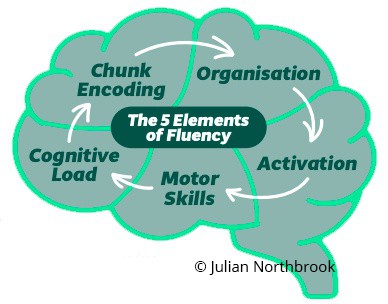I created the first video on YouTube about using Shadowing for English as far as I know, so I think I’m definitely the right person to answer this question 🙂
What I’ll write here is a greatly updated shadowing guide (taken from my free ‘Good Shadowing Guide’).
First, shadowing is great exercise. But the way most people use it is kinda wrong, and so they don’t get the results they expect.
Here’s how to make it work for you:
Step 1: Understand the 5 Elements of Fluency
Have a look at this diagram:

Shadowing is just one of the exercises my clients use to develop the 4th Element of Fluency: Motor Skills.
True fluency in English is a combination of 5 elements working together. First, you have to ‘encode’ the blocks of English you need in subconscious memory. Next, you organise these into topics in your mind. Your English has to be properly “activated” to prevent translating from your first language, as well as that slow feeling when you try to speak…
Motor Skill is the physical aspect of fluency — this is all about your mouth and face muscles moving correctly, with the right rhythm and quality. Again, shadowing is one of the important exercises we use to develop this part of speech.
Finally, fluent English also requires you to reduce “cognitive load”. This is a technical term, but it is similar to your computer’s RAM — if you have a lot of software programs open at once, your computer will run slowly and overheat. Speaking English is the same.
Step 2: Is Shadadowing the right exercise for you?
Shadowing is a powerful exercise … but only if used correctly.
Many people say to me:
“Julian, I’m doing Shadowing but I’m not getting fluent – why?”
The answer is always the same: they’re using it incorrectly. It’s like they’re trying to use a screwdriver to put in a nail… when what they should be using is a hammer.
What Shadowing Is:
Shadowing is used to develop physical fluency in English to sound smooth, fluent and easy to understand. But that’s all it’s useful for.
What shadowing is definitely not:
Shadowing is not a method, and it is not a “magic pill”.
Just doing shadowing will not make you master English. This is like taking painkillers for a headache when actually you have a brain tumour and need surgery (this happened to my friend). Different problem, different solution. If your problem is related to one of the other ‘Elements of Fluency’, you will need a different exercise to improve fastest.
Step 3: How to “Shadow”
Shadowing is fun and Rinse and Repeat easy to do. All you need are high-quality materials with a natural audio version (don’t use the audio from textbooks, as this isn’t natural English). My Extraordinary English Speakers use the ones I give them every week.
Once you have this, follow these simple steps:
- Study your materials. Aim to understand 100%.
- Listen very carefully to the way the speaker “chunks” his or her speech — listen to how the words are crushed together, the pauses, intonation, rhythm and the way the speaker speeds up and slows down.
- With the script in front of you, listen to the audio. Simultaneously mimic the speaker. Again, pay special attention to the things mentioned above. Try to match your speech perfectly to the speaker.
- When you feel comfortable with the script, try shadowing using the audio alone. Don’t try to memorise the English — just focus on the rhythm, flow and ‘chunking’ of what the speaker is saying.
Then it’s just a case of rinsing and Repeating.
There is no correct amount of time to do this. Just do it for a few minutes each day, spending as much (or as little) time on each of your materials as you need to feel comfortable with it.
But here are some additional tips to make it even more effective:
Step 4: Don’t say every word 3 — “Chunk” it
People who pronounce every individual word carefully are very difficult for native speakers to understand.
Why?
Because native speakers are not speaking or listening using individual words and grammar rules like you were taught in school.
How native speakers really speak
Native speakers store blocks of words called ‘chunks’ in long term memory. This allows us to speak fluently because we don’t have to ‘compute’ everything we say like a mathematician working on solving complex equations. This works two ways: we can only listen in a fluent, chunked way if YOU speak in a fluent chunked way.
This is why something like “make a picture” sounds awkward and unnatural (yes; it is grammatical) but “take a picture” sounds natural.
Practise “chunked” speech with shadowing
Pay close attention to chunking when shadowing. It will make you much easier to understand, and your friends will thank you for it.
Step 5: Understand that Native Speakers don’t speak ‘Fast’
Do you believe natives speak fast?
Well, It’s not true.
We don’t speak fast… or at least, not all (or most) of the time. But we do use the speed of our voice to add meaning to what we’re saying. When a speaker wants to convey how excited they are or make it dramatic, they will speed up. When they are emphasising a point or talking about something sad, they will slow down. They will use long pauses for effect.
Shadowing forces you to pay attention and copy this: which is one of the reasons I have my clients use the exercise regularly.
Chunks Sound Fast… but they aren’t
Remember: native speakers speak in chunks. When we say something like, “let”s give it a go” we naturally blend all the sounds together, and it is pronounced as a single unit. When we say, “let’s try to do it” (not a chunk), we don’t blend the sounds. This is a common feature of chunks — the more frequent they are, the stronger the blending. As I said before, you need to pay attention to this.
Step 6: If you’re finding 5 Shadowing hard…
Shadowing is an intensive exercise, and it should make you tired physically (your mouth and face muscles). It should also make you mentally tired.
But shadowing shouldn’t be difficult.
If you are finding it difficult, you probably need to do other exercises to develop the other 4 Elements of Fluency.
For example, if you haven’t done the “Chunk Encoding” part right (the 1st Element of Fluency), you will find it very difficult to keep up with the speaker, and will make mistakes and say things wrong.
This is the same in real conversation If you make mistakes or say unnatural things, you probably need to focus on encoding first. If you translate in your head in conversation or find your English feels slow and ‘asleep’, you need to work on activation. If you panic or are stressed when speaking, you need to work on reducing cognitive load. If your English gets confused and messy, it’s because it is not properly organised in your brain.
In a nutshell: you need to use the right exercises for your specific problems.
If you found this guide useful and want to go further
If you want to download and keep this guide, I created an illustrated pdf here (it’s free).
To go further into fluency, and how to improve as a high-intermediate learner I created this free training. It’ll teach you the key changes you need to make to the way you learn to see real improvement.
Hope this helps.
Best,
Julian Northbrook


